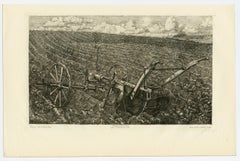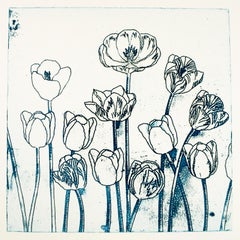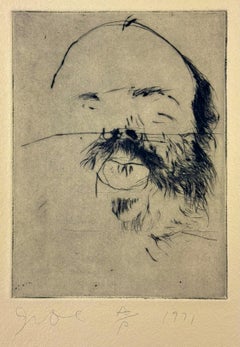Pieter Dupont Art
to
1
1
1
Overall Height
to
Overall Width
to
1
1
1
1
1
1
1
1
1
1
6,857
3,172
2,516
1,217
1
Artist: Pieter Dupont
"La charrue" original etching
By Pieter Dupont
Located in Henderson, NV
Medium: original etching. This impression on japon paper was printed in 1902 and published in Paris by the by Gazette des Beaux Arts. Image size: 5 x 8 1/2 inches (127 x 213 mm). Not...
Category
Early 1900s Realist Pieter Dupont Art
Materials
Etching
Related Items
Blue Tulips by Jim Dine, blue flower etching
By Jim Dine
Located in New York, NY
A spray of tulips printed in vibrant cerulean blue emerges at the center of this floral etching by Jim Dine. The artist’s line drawing conveys the swaying of spring tulips in a sligh...
Category
1970s Realist Pieter Dupont Art
Materials
Etching
Self Portrait by Jim Dine (plate seven from Self Portraits portfolio 1971)
By Jim Dine
Located in New York, NY
Jim Dine, Self Portrait 1971
drypoint on Hodgkinson Hand Made Tone-Weave paper
Paper 18 x 14 in. / 46 x 36 cm
Plate 8 x 6 in. / 20 x 15 cm
plate seven from Self Portraits (1971) port...
Category
1970s Realist Pieter Dupont Art
Materials
Etching, Drypoint
Memorial Bridge, Springfield, Mass
By Wolf Kahn
Located in New York, NY
Wolf Kahn
Untitled, 1982
Original Etching
10 × 15 inches
Edition AP (aside from the regular edition of 90)
pencil signed, dated and inscribed to Cynthia
Frame included: Ships framed...
Category
1980s Realist Pieter Dupont Art
Materials
Etching
Old Town, paper, etching, 32x24.5 cm
Located in Riga, LV
Old Town, paper, etching, 32x24.5 cm
Piotr Petrovich Belousov (1912-1989)
was a Soviet, Russian painter, graphic artist, art teacher, professor of the Leningrad Institute of Paintin...
Category
Mid-20th Century Realist Pieter Dupont Art
Materials
Etching
The Pantheon in Rome: A 19th Century Etching by Cottafavi
Located in Alamo, CA
This is a 19th century architectural etching of the Pantheon in Rome entitled "Panteon di Agrippa detta La Rotonda", plate 9 from "Raccolta delle principali vedute di Roma e...
Category
Mid-19th Century Realist Pieter Dupont Art
Materials
Etching
Evening - The depth of the visible -
Located in Berlin, DE
Max Clarenbach (1880 Neuss - Cologne 1952), Evening. Etching, 18 x 41 cm (platemark), 33.5 x 57 cm (frame), inscribed "Abend" in pencil at lower left, signed and dated "M. Clarenbach. 28.III.[19]09". Framed and mounted under glass.
- Somewhat browned and slightly foxed.
About the artwork
The horizontally elongated etching depicts the panoramic view of a small town as seen from the other side of the river. There are gabled houses on the left and a mighty church spire on the right. The bourgeois houses and the large religious building indicate the urban character. These buildings are rendered in dark tones to emphasise the lighter row of houses in the centre of the picture, closer to the water. The chiaroscuro contrast creates two parallel planes that open up a space for the imagination of what the city could be. The imagination is stimulated by the almost entirely dark, barely recognisable buildings, while the arm of the river leading into the city further stimulates the imagination.
However, as the silhouette of the city as a whole is reflected in the water, the parallel planes are perceived as a band of houses that stretches across the entire horizontality of the etching and seems to continue beyond the borders of the picture. The reflection has almost the same intensity as the houses themselves, so that the band of buildings merges with their reflection to form the dominant formal unit of the picture. Only the parallel horizontal hatching creates the convincing impression of seeing water, demonstrating Max Clarenbach's mastery of the etching needle.
The water is completely motionless, the reflection unclouded by the slightest movement of the waves, creating a symmetry within the formal unity of the cityscape and its reflection that goes beyond the motif of a mere cityscape. A pictorial order is established that integrates everything in the picture and has a metaphysical character as a structure of order that transcends the individual things. This pictorial order is not only relevant in the pictorial world, but the picture itself reveals the order of the reality it depicts. Revealing the metaphysical order of reality in the structures of its visibility is what drives Clarenbach as an artist and motivates him to return to the same circle of motifs.
The symmetry described is at the same time inherent an asymmetry that is a reflection on art: While the real cityscape is cut off at the top of the picture, two chimneys and above all the church tower are not visible, the reflection illustrates reality in its entirety. The reflection occupies a much larger space in the picture than reality itself. Since antiquity, art has been understood primarily as a reflection of reality, but here Clarenbach makes it clear that art is not a mere appearance, which can at best be a reflection of reality, but that art has the potential to reveal reality itself.
The revealed structure of order is by no means purely formalistic; it appears at the same time as the mood of the landscape. The picture is filled with an almost sacred silence. Nothing in the picture evokes a sound, and there is complete stillness. There are no people in Clarenbach's landscape paintings to bring action into the picture. Not even we ourselves are assigned a viewing position in the picture, so that we do not become thematic subjects of action. Clarenbach also refrains from depicting technical achievements. The absence of man and technology creates an atmosphere of timelessness. Even if the specific date proves that Clarenbach is depicting something that happened before his eyes, without the date we would not be able to say which decade, or even which century, we are in. The motionless stillness, then, does not result in time being frozen in the picture, but rather in a timeless eternity that is nevertheless, as the title "Abend" (evening), added by Clarenbach himself, makes clear, a phenomenon of transition. The landscape of the stalls is about to be completely plunged into darkness, the buildings behind it only faintly discernible. The slightly darkened state of the sheet is in keeping with this transitional quality, which also lends the scene a sepia quality that underlines its timelessness. And yet the depiction is tied to a very specific time. Clarenbach dates the picture to the evening of 28 March 1909, which does not refer to the making of the etching, but to the capture of the landscape's essence in the landscape itself.
If the real landscape is thus in a state of transition, and therefore something ephemeral, art reveals its true nature in that reality, subject to the flow of phenomena, is transferred to an eternal moment, subject to a supra-temporal structure of order - revealed by art. Despite this supratemporality, the picture also shows the harbingers of night as the coming darkening of the world, which gives the picture a deeply melancholy quality, enhanced by the browning of the leaf.
It is the philosophical content and the lyrical-melancholic effect of the graphic that give it its enchanting power. Once we are immersed in the image, it literally takes a jerk to disengage from it.
This etching, so characteristic of Max Clarenbach's art, is - not least because of its dimensions - a major work in his graphic oeuvre.
About the artist
Born into poverty and orphaned at an early age, the artistically gifted young Max Clarenbach was discovered by Andreas Achenbach and admitted to the Düsseldorf Art Academy at the age of 13.
"Completely penniless, I worked for an uncle in a cardboard factory in the evenings to pay for my studies.”
- Max Clarenbach
At the academy he studied under Arthur Kampf, among others, and in 1897 was accepted into Eugen Dücker...
Category
Early 1900s Realist Pieter Dupont Art
Materials
Etching
Self Portrait by Jim Dine (plate four from Self Portraits portfolio 1971)
By Jim Dine
Located in New York, NY
Jim Dine, Self Portrait
drypoint on Hodgkinson Hand Made Tone-Weave paper
Paper 18 x 14 in. / 46 x 36 cm
Plate 8 x 6 in. / 20 x 15 cm
plate one from Self Portraits (1971) portfolio ...
Category
1970s Realist Pieter Dupont Art
Materials
Etching, Drypoint
A Jew
By Hermann Struck
Located in Raleigh, NC
Etching by Hermann Struck in good condition with slight light staining
Category
1930s Realist Pieter Dupont Art
Materials
Etching
Forest Road Paper, etching, 21.5x28.5 cm
Located in Riga, LV
Forest Road, paper, etching, 21.5x28.5 cm
Piotr Petrovich Belousov (1912-1989)
was a Soviet, Russian painter, graphic artist, art teacher, professor of the Leningrad Institute of Pa...
Category
Mid-20th Century Realist Pieter Dupont Art
Materials
Etching
César - Centaur - Picasso's Homage - Original Signed Etching
By César Baldaccini
Located in Collonge Bellerive, Geneve, CH
César Baldaccini
Original Etching
Dimensions: 56.5 x 40 cm
Signed and Numbered
Edition of 99
It is the only original etching ever made by César.
César Baldaccini was born in Marseille in 1921. At the age of 12, he left the school to help his father, cooper. At 15 years old, he studied at the Art college of Marseille. He took evening drawing teachings, and then was interested in sculpture until 1939.
In 1942, César received a scholarship and went to Paris. He studied ten years at the School of Beaux-Arts; he worked in the studios of Gaumont and Alfred Jeanniot and was named “Grand Massier” (teacher) of this school. At that time, he was living in the same house as Alberto Giacometti.
In 1944, short of resources, he went to Marseille, then return to Paris, next year. With the 50s, he made discovered his work through his first exhibitions. One of its works (« The fish ») obtained a place in the Museum of Modern Art in Paris (1955). Henceforth, he exhibited ceaselessly, participating in numerous “Salons” in France and abroad. César received numerous prices there. He got personal exhibitions everywhere (Japan, the United States, Holland, France, Italy, etc.). Important retrospectives came, later. In 1970, he was named professor a foreman to the School of Beaux-Arts in Paris.
During his all life, Caesar was stimulated by « the love of the profession » and by an extraordinary will to innovate. The humor of the man did not miss and was noticed through his work. Pablo Picasso was his major reference, also Alberto Giacometti, Germaine Richier, Pablo Gargallo and Julio Gonzales...
Category
1980s Realist Pieter Dupont Art
Materials
Etching
H 15.75 in W 22.25 in D 0.4 in
The Thames, 1894 - Victorian aquatint etching of London by Joseph Pennell
By Joseph Pennell
Located in London, GB
JOSEPH PENNELL
(1857-1926)
The Thames, 1894
Signed
Aquatint
Plate size 20.5 by 26.5 cm., 8 by 10 ½ in.
(frame size 42 by 46 cm., 16 ½ by 18 in.)
Pennell was born in Philadelphia where he studied at School of Industrial Art and the Academy of Fine Arts. In 1884 he was commissioned by the Century Magazine to supply a series of drawings of London...
Category
1890s Realist Pieter Dupont Art
Materials
Aquatint
Cyril's Bay - Peter Doig, Contemporary, 21st Century, Magic Realism, Edition
By Peter Doig
Located in Zug, CH
Cyril's Bay - Peter Doig, Contemporary, 21st Century, Magic Realism, Limited Edition
Digital pigment print with silkscreen varnish on Somerset Velvet 255gsm with hand torn edges
Edit...
Category
Early 2000s Realist Pieter Dupont Art
Materials
Etching
Pieter Dupont art for sale on 1stDibs.
Find a wide variety of authentic Pieter Dupont art available for sale on 1stDibs. You can also browse by medium to find art by Pieter Dupont in etching and more. Not every interior allows for large Pieter Dupont art, so small editions measuring 9 inches across are available. Customers who are interested in this artist might also find the work of Adriaan Lubbers, Pieter Van Der Aa, and Alexandre Lunois. Pieter Dupont art prices can differ depending upon medium, time period and other attributes. On 1stDibs, the price for these items starts at $200 and tops out at $200, while the average work can sell for $200.


